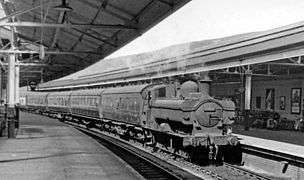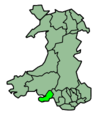Swansea railway station
| Swansea | |
|---|---|
| Welsh: Abertawe | |
 | |
| Location | |
| Place | Swansea |
| Local authority | City and County of Swansea |
| Coordinates | 51°37′31″N 3°56′27″W / 51.6253°N 3.9409°WCoordinates: 51°37′31″N 3°56′27″W / 51.6253°N 3.9409°W |
| Grid reference | SS657936 |
| Operations | |
| Station code | SWA |
| Managed by | Arriva Trains Wales |
| Number of platforms | 4 |
| DfT category | C1 |
|
Live arrivals/departures, station information and onward connections from National Rail Enquiries | |
| Annual rail passenger usage* | |
| 2004/05 | 1.386 million |
| 2005/06 |
|
| 2006/07 |
|
| 2007/08 |
|
| 2008/09 |
|
| 2009/10 |
|
| 2010/11 |
|
| 2011/12 |
|
| 2012/13 |
|
| 2013/14 |
|
| 2014/15 |
|
| History | |
| Original company | South Wales Railway |
| Pre-grouping | Great Western Railway |
| Post-grouping | Great Western Railway |
| 19 June 1850 | Opened as Swansea High Street |
| 6 May 1968 | Renamed Swansea |
| National Rail – UK railway stations | |
| * Annual estimated passenger usage based on sales of tickets in stated financial year(s) which end or originate at Swansea from Office of Rail and Road statistics. Methodology may vary year on year. | |
|
| |
Swansea railway station is a railway station serving Swansea, Wales, and is the fourth busiest in Wales after Cardiff Central, Cardiff Queen Street and Newport.
History
The station opened in 1850.[1] It was built by the South Wales Railway, which amalgamated with the Great Western Railway (GWR) in 1863,[1] but it was not originally on the South Wales Railway main line, planned to connect London with the port of Fishguard, and Swansea passengers had to change at Landore, two miles to the north until at least 1879. The station has been renovated and extended several times in its lifetime - most notably in the 1880s, when the stone-built office block facing High Street, on the west side of the station, was added, and in 1925-7 when the platforms were lengthened.[2] The present-day frontage block, facing Ivey Place, was completed in 1934. Nothing now remains of the original wooden station with its two platforms and galvanised iron roof.
The majority of the rebuilt station remains intact, although the facilities have been reduced. The umbrella-type platform roofing which replaced the 1880s train-sheds in the 1920s is mostly intact although the canopy on platform 4 has been shortened. The number of platforms was reduced from five to four in 1973 under British Rail when the old Platform 1 was eliminated, along with the loading bays and fish dock that once stood beyond it. The remaining platforms were renumbered at the same time, so that what were platforms 2 to 5 are now platforms 1 to 4, respectively. On the east side of the station there was a connecting line which bypassed the platforms and ran at one time to coal tips on the North Dock (closed in 1929 and subsequently infilled) and on to a junction with the high-level line from Eastern Depot to Victoria station (closed in 1965). Part of the route of this line, alongside the station itself, is now a staff car park and the remainder, which was carried on viaducts alongside the Strand, has been obliterated by modern development. High Street goods station was on the west side of the line, just north of the passenger station. The site has been completely cleared and used for housing and also the dedicated bus road that runs from the Landore park-and-ride facility into the city centre. On the opposite side of the line were extensive carriage sidings (Maliphant sidings), large areas of which are, as of 2014, being redeveloped as the Hitachi IEP (Intercity Express Programme) rail service depot.

There was great competition between the different railway companies in the nineteenth and early twentieth centuries. Swansea had seven stations in 1895, owned by five different railway companies: High Street (GWR), St Thomas (Midland Railway), East Dock (GWR), Riverside (Rhondda & Swansea Bay Railway, by which it was called simply Swansea; renamed Swansea Docks by the GWR in 1924 and Riverside two years later[3]), Victoria and Swansea Bay (both London & North Western Railway), and Rutland Street (the town terminus of the Mumbles Railway). Only High Street now remains in the city centre.
Services

To the east, trains operate along the South Wales Main Line. Swansea is a western terminus for Great Western Railway inter-city services to London Paddington that do not terminate at Cardiff Central,[4] with the majority of local train services west of Swansea timed to connect with London services.[5]Arriva Trains Wales provides the Swanline service to Cardiff Central (for connections to the South Wales Valleys, Bristol Temple Meads, Taunton, Southampton Central, Portsmouth Harbour, Gloucester, Birmingham New Street and Nottingham), and services to Manchester Piccadilly.[6]
To the west, Arriva Trains Wales trains run along the West Wales Line to Carmarthen and then to Pembroke Dock, Milford Haven or Fishguard Harbour. Certain services to Fishguard Harbour connect with the Stena Line ferry to Rosslare Europort in Ireland. Swansea is the eastern terminus for a few of the services from West Wales.[7] Services on the Heart of Wales Line between Llanelli and Shrewsbury often start from Swansea.[8]
Rail & sea corridor to Ireland
Some of the Arriva Trains Wales boat trains to and from Fishguard Harbour commence at Swansea. These connect with the Stena Line ferry to Rosslare Europort in Ireland with a daily morning and evening service in both directions. This route has been in existence since 1906.
Description
The station is a terminus, at the end of a short branch off the South Wales Main Line and the West Wales Line, so that all through passenger trains must either reverse at Swansea or omit calling there. In practice, almost all passenger services do call there.[7]
The station has four platforms. Great Western Railway trains from London normally enter the station with the standard-class carriages leading, and usually use platform 2. The platforms are covered for part of their length.
Until January 2004, the mail train to London was a regular service from the station.[9]
In February 2013, Swansea station won the "Wales’ Best Staffed Train Station" award, supported by Keep Wales Tidy.[10]
In May 2013, Swansea station was named "International Station of the Year" and won the "Best Large Station" award at the International Station Awards.[11]
Platforms
Swansea has four platforms, numbered 1, 2, 3 and 4. Platforms are generally used for the same services, but can change if it is not available. The normal pattern is the following:
- Platform 1
- Arriva Trains Wales:
- Manchester Piccadilly via Newport, Hereford, Shrewsbury and Crewe from either Carmarthen or Milford Haven
- Fishguard Harbour via Llanelli, Pembrey and Burry Port, Carmarthen and Clarbeston Road. Some services originate from either Cardiff Central or Cheltenham Spa.
- Terminating services from Shrewsbury via Ammanford and Pontarddulais.
- Arriva Trains Wales:
- Platform 2
- Great Western Railway:
- London Paddington, Carmarthen, Pembroke Dock via Cardiff Central, Bristol Parkway, Swindon and Reading.
- Terminating services from London Paddington via Cardiff Central.
- Great Western Railway:
- Platform 3
- Arriva Trains Wales:
- Carmarthen via Gowerton from either Cardiff Central or Manchester Piccadilly
- Shrewsbury/Crewe via Pontarddulais that start at Swansea. Some services originate from Cardiff Central
- Milford Haven via Carmarthen from either Cardiff Central or Manchester Piccadilly
- Terminating services from Ebbw Vale Parkway via Cardiff Central.
- Great Western Railway:
- Terminating services from London Paddington via Cardiff Central.
- Arriva Trains Wales:
- Platform 4
- Arriva Trains Wales & Swanline:
- Cardiff Central via Neath that start at Swansea.
- Terminating services from Cardiff Central.
- Pembroke Dock via Carmarthen
- Arriva Trains Wales & Swanline:
Name of the station
For most of its history the station was known as Swansea High Street to distinguish it from other stations in the area. Following Beeching's cuts in the 1960s and the closure of Swansea Victoria, the name was shortened to Swansea. Today the station is called Abertawe/Swansea on platform signs, the facade, public timetables, by the National Assembly of Wales and by Swansea County Council.[12][13] Before the station was re-vamped, a sign above the station entrance said High Street Station, as does Network Rail route documentation.[14]
Future development
Swansea station is currently being revamped, with new facilities including new waiting rooms, bicycle racks and digital information boards. The first phase was completed in June 2012 and officially opened by the Welsh Government Minister with responsibility for Transport, Carl Sargeant, on Monday 11 June.[15] The second phase was due to be completed by 2014, when the whole project for the other stations is said to be completed as well.[16][17]
Routes
| Preceding station | |
Following station | ||
|---|---|---|---|---|
| Llansamlet | Arriva Trains Wales South Wales Main Line |
Terminus | ||
| Arriva Trains Wales West Wales Line |
Gowerton | |||
| Gowerton | Arriva Trains Wales Heart of Wales Line |
Terminus | ||
| Neath | Great Western Railway London Paddington-South Wales |
Terminus | ||
| Great Western Railway London Paddington-Carmarthen or London Paddington-Pembroke Dock |
Llanelli | |||
See also
References
- 1 2 History of the Great Western Railway, E.T. MacDermot (rev. C.R. Clinker, pub. Ian Allan, 1964)
- ↑ Track Layout Diagrams of the GWR and BR (Western Region), R.A. Cooke (self-published)
- ↑ C.R. Clinker, Clinker's Register of Closed Passenger Stations and Goods Depots in England, Wales and Scotland, 1830-1977, AvonAnglia Publications, Bristol, 1978
- ↑
- ↑ Route 14 South and Central Wales and Borders
- ↑ South Wales to North Wales and Manchester, Train Times 17 May to 12 December 2009
- 1 2 Arriva Trains Wales: West Wales to Swansea timetable
- ↑ Arriva Trains Wales: Heart of Wales Line: Shrewsbury - Llandrindod - Swansea timetable
- ↑ BBC NEWS | England | End of line for mail trains
- ↑ http://www.keepwalestidy.org/10408
- ↑ http://www.thisissouthwales.co.uk/Swansea-Station-named-UK-s-best-following-7/story-18879502-detail/story.html#axzz2TjpwhM2z
- ↑ City and Council of Swansea: Passenger Transport
- ↑ RES Annual Conference 2004 - Information
- ↑ National Rail Enquiries: Station Facilities: Swansea
- ↑ http://wales.gov.uk/newsroom/transport/2012/120611swanseatrainstation/?lang=en
- ↑ "City rail station to be revamped". BBC News. 8 February 2010. Retrieved 24 May 2010.
- ↑ http://rail-news.com/2010/02/08/transformation-of-swansea-station-unveiled/
- R.V.J.Butt, (1995). The Directory of Railway Stations. Patrick Stephens Ltd. ISBN 1-85260-508-1.
- A. Jowett, (2000). Jowett's Nationalised Railway Atlas. Atlantic Publishing. ISBN 0-906899-99-0.
- Railways around Swansea factsheet from Swansea Museums Service
- The South Wales Railway factsheet from Swansea Museums Service
Further reading
- "Swansea station improvements". Rail Enthusiast. EMAP National Publications. October 1984. p. 16. ISSN 0262-561X. OCLC 49957965.
External links
| Wikimedia Commons has media related to Swansea railway station. |
- Train times and station information for Swansea railway station from National Rail
- Station on navigable O. S. map
- Great Western IEP Network Master Availability And Reliability Agreement
- Photographs of the station through the years
